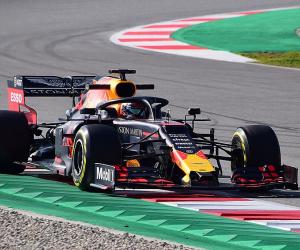Ahead of this weekend’s season opener, Dalraj Bahia, managing director of operations at Sportradar, highlights the huge opportunities a live F1 betting product offers, and lifts the lid on the complexities of delivering real-time data and odds
 With Formula 1 undergoing a major strategic effort to increase global fan engagement, there is no better time to evolve the F1 betting experience and help drive operators to reach new audiences.
With Formula 1 undergoing a major strategic effort to increase global fan engagement, there is no better time to evolve the F1 betting experience and help drive operators to reach new audiences.
Historically, the industry has stalled when it has come to combining betting and premium motor sport, with no access to real-time data analytics to provide exciting in-race products.
As a result, bookmakers have been limited to manual trading and very few markets such as race winner and podium finish.

Working in partnership with F1 and utilising advanced technology and trading methods, combined with access to more than 70 years’ of historical data, we are taking the sport to new heights, feeding it into the betting ecosystem to provide new revenue streams and boosting fan engagement among a passionate audience of global motor racing fans.
As official data partners we have accessed a deep level of untapped historical data that stretches as far back as the 1950s, as well as live feeds from individually fitted trackside sensors with data uploaded with sub-second latency.
This data is fundamental to unlocking the sport’s full potential and opening it up to a new generation of fans. We have achieved this by feeding this rich library of information into sophisticated AI and machine learning technology that continually develops and trains our models to generate the most accurate odds, which are then powered by real-time data.
Complexities in capturing data
Processing the millions of data points F1 creates every second, however, means that developing such a product is a highly complex operation.
From lights out on race day, 20 million data points are captured every second from the cars alone, and when you factor into the equation the trackside sensors that are fitted around the circuit, billions more are generated every race.
This is far greater than other sports such as soccer for example, where the 22 players on the pitch are the main variables alongside their recent form, how they perform as a team, the score at a given time, and minutes left on the clock. In F1 the variables are infinite. There are 20 drivers, car performance changes minute-by-minute and session-by-session, with cars performing better on certain tracks and in certain weather conditions.
This is just the beginning. Within races there are also multiple tyre choices and strategies, various levels of tyre degradation and management, pit stops, changes in weather, drag reduction system impacts, and certain cars that perform better when leading from the outset compared to being in the chasing pack, which can drastically alter expected race performance.
Then, factor in reliability issues which affects lap-by-lap markets, and even the impact of a safety car. For instance, at the Monza grand prix last year a red flag enabled race outsider Pierre Gasly to unexpectedly win his maiden Grand Prix, changing the course of the race in a split second.
There is an abundance of variables, all of which constantly change in real-time. Historical data has been critical to training our odds models which we then use to interpret that ever changing data, and generate probabilities which are brought to life by our expert quantitative analysts using a unique blend of mathematical and statistical methodologies.
Developing effective live odds and live data
Real-time data provides a significant challenge when filtering all the relevant information to produce accurate odds and a multitude of compelling, innovative markets.
To overcome this hurdle, super low sub-second latency teamed with superior knowledge and years of experience is required to turn this information into a viable betting product. This is imperative for pricing accuracy, especially as new in-race markets such as ‘first to pit’ or ‘first to retire’ need to have the very latest data available.
Other new innovative in-race markets such as various head-to-heads, fastest lap markets, or number of overtakes, are also entirely dependent on real-time, accurate data. We therefore cannot afford to be behind the action, and low latency data is essential alongside concrete resulting methodology.
Bookmakers greatly benefit from sub-second latency. Live data, for example, is made available to operators that wish to price and trade odds themselves. This is a curated stream of critical data points and events as each race progresses, including all the necessary information for trading such as rich information on lap and sector times and pit stops.
Thanks to our proprietary technology backbone, we can curate and deliver data points within 50 to 300 milliseconds. Compared to the ways bookmakers previously offered F1 markets, this is a game changer for the industry.
Driving a more immersive experience
In recent times, F1 has capitalised on the richness of its data to bring further insight to global audiences. Having 70 years of historical information, combined with real-time data and technology, is now enabling us to bring this data to life to create a truly immersive experience and keep fans engaged throughout the entire race weekend.
Visualisation is key and our Live Race Tracker provides fans with every relevant data point and insights to enable them to enjoy the excitement in new ways and better inform their betting as each race progresses.
Alongside fundamental information such as weather and number of laps, each car and driver are plotted in real time across the track. This is complemented by a race timeline, which is akin to line-by-line commentary that provides information on every area of race, for example as individual drivers enter the pits or as soon as a flag is waved. In addition, fans can enjoy head-to-head information, select which drivers they want to watch and track, compare tyre selection, pit stops and much more while also engaging with live leaderboards and driver standings.
This rich breadth of information for fans to enjoy will naturally lead to greater engagement, as we have seen across other sports where real-time statistics help to inform bettors and influence their decision-making.
The potential for F1 betting is enormous. As betting models become more sophisticated and can digest more data sets, the possibilities are endless. We anticipate the development of more markets in the future, and for the sport to become an increasingly important long-term betting product for bookmakers to attract new punters to their platform.












